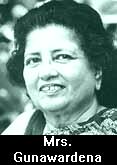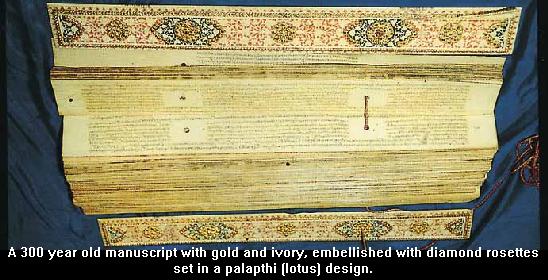


![]()
 Perhaps
it was her fascinationfor collecting bits and pieces; maybe it was the
wanderlust her father instilled in her or the joy of searching for treasures of
wisdom in forgotten corners, that led Sirancee Gunawardana on an unchartered
voyage, spanning 12 years of research into palm leaf manuscripts dating from the
13th -19th century.
Perhaps
it was her fascinationfor collecting bits and pieces; maybe it was the
wanderlust her father instilled in her or the joy of searching for treasures of
wisdom in forgotten corners, that led Sirancee Gunawardana on an unchartered
voyage, spanning 12 years of research into palm leaf manuscripts dating from the
13th -19th century.
Her discoveries are told to us in a 350 page volume titled "Palm Leaf Manuscripts of Sri Lanka", probably the first such permanent record in an accessible form, complete with photographs (some microfilmed) and drawings. Praised as a "comprehensive and scholarly survey of palm leaf manuscripts and illustrations" in the foreword by Prof. Senake Bandaranayake, Director General, Central Cultural Fund, the book unravels a wealth of knowledge on Buddhism, traditional medicine, social customs that existed from the 5th-19th century, music, architecture, archaeology and history.
 While
turning its pages I was amazed at the labour of love that had inspired a
seemingly endless process of personally examining, collecting, compiling,
translating and copying drawings from rare manuscripts in temples, museums and
private collections all over the island. "It was certainly a very
time-consuming and physically exhausting process," Ms. Gunawardana said.
While
turning its pages I was amazed at the labour of love that had inspired a
seemingly endless process of personally examining, collecting, compiling,
translating and copying drawings from rare manuscripts in temples, museums and
private collections all over the island. "It was certainly a very
time-consuming and physically exhausting process," Ms. Gunawardana said.
"I would bend and peer at around 50 manuscripts per day, and as most of them were either in Pali or Sanskrit, I had to depend on someone else's assistance. What made the research even more laborious was the absence of proper catalogues and classified indexes. The higgledy-piggledy state the manuscripts were in thus made the research very slow and frustrating."
With no financial assistance given or sought, her main motivator was indeed a "sheer love of research and zest for things of cultural value". This was what kept her going through the many times when heavy, dusty 600 year old manuscripts fell on her head while trying to take them out of cupboards, the many days when she used to return home with an aching back and eyes resembling red cherries after a day spent copying microscopic, detailed drawings, and the many moments when much red tape had to be cleared to enable continued research.
How did the journey begin? It goes back to a childhood of waking up to her father taking her to Pomparippu to see the burial grounds, teaching her the importance of soil conservation and wild life protection, showing her the charm of a dew drop on a cobweb.....
It was this initiation into finding beauty in the simplest things, unearthing archaeological traces of a country's cultural heritage, always searching, searching for knowledge and information on an assortment of subjects, that was to become this journey's first step. Armed with a magnifying glass, architect's paper, a pen and a notebook, Ms. Gunawardana would set off on her quest of personal satisfaction." It was only two years ago that I decided to publish my findings in a book. I was delighted and awestruck by the insightful information I had gathered along the way and wanted to put it all together for public appreciation of our country's medieval book craft."
And to resolve the problem of haphazard inventory, she personally reclassified and catalogued alphabetically all the palm leaf manuscripts she came across, resulting in an easy-to-read beautifully cross-referenced book which could well serve to inspire future research by any scholar.
Its contents include examples of Sanskrit literature, the palaeographic development of the Sinhalese language, vaidya silpa (herbal medicine), nila vidum (acupuncture), ancient cook books, Sinhalese ballads, the social caste system, child slavery and the earliest extant bird mission Kavya poems (among them the Mayura, Selalihini and Gira Sandesayas). Ms. Gunawardana also explained the long process of layering, boiling, polishing, washing and drying which preceded the making of a puskola potha (ola), and the difficulty in reading and understanding its contents, as sometimes the leaf folios were attacked by silverfish leaving parts missing, and the absence of punctuation marks and spaces between words to identify when a sentence began or ended.
However, she continued undaunted in her task and has throughout her years of research referred to manuscripts in universities, medical libraries and institutes of indigenous medicine. She has also examined the 13th century Culavagga, the oldest manuscript extant in the country, the Pansiya Panas Jataka with 1000 folios and 547 Jataka Stories, the 400 year old Pali chronicle - the Mahavamsa-the Hugh Neville Collection at the Albert and Victoria Museum in London where 2469 manuscripts were taken from Sri Lanka, and libraries and museums in Copenhangen, Munich, Paris, Amsterdam and Oxford.
Having read Economics, History and Philosophy for her degree at the University of Ceylon, Mrs. Gunawardana also holds a M.Sc from the Postgraduate Institute of Archaeology, University of Kelaniya, a Diploma in Buddhist Studies, University of Kelaniya (although being a devout Christian) and a Certificate in Education from the University of Oxford. She has also been featured in the Cambridge Who's Who of Intellectuals, is the Editor of the 'Loris', the journal of the Wildlife and Nature Protection Society and of course the much-loved principal of Ladies College.
On her desk lay scattered a book that had to be reviewed, an unfinished paper on literacy and education for a SAARC conference organised by the University Federation and many other papers and pieces that needed her urgent attention.
It is very apparent that time is never a constraint for Ms. Gunawardana. "If you really care about something you will always make time for it." She thus lists a number of other interests, among them travel journalism, art and sculpture.
"Whenever I get the chance I make time for young children. It is important that they always keep an open mind and appreciate and enjoy life to the fullest," she enthused.
In a fitting tribute to her father, C. Selwyn Samaraweera, Proctor, Supreme Court and Notary Public, to whom her book is dedicated, she says, "no words can convey the joy and feeling of exultation I have experienced peering into dusty nooks and cobweb encrusted wooden boxes and cupboards", to find evidence of the overall socio-political development of a country through its first 'books' preserving it for future generations.
Some of the gems within its pages are a love song written by King Kirti Sri Rajasingha to his mistress, acupuncture treatment for elephant ulcers, a typical prescription for fever which includes pepiliya, tippli, shevantha, sandun and kottamalli put into a cut king coconut and drunk, remedies for snake bites, illustrations on stick and sword dances, agricultural songs, yantra to be used when possessed by devils and categories of huniyam, some of which are said to cause immediate death to the victim on completion of the ritual.
Other bits of quaint information include cosmetic treatment from a Talipot medical manuscript - grind 12 kalandas ( which should be the weight of 20 madatiya seeds), the gum of imbul, ghee and sugar to a fine paste, add wara kiri and mix well. This preparation is guaranteed to make you "as beautiful as a red rose."
Ayurvedic manuscripts which are lavishly illustrated include tips on techniques for acupuncture, indicating the pressure points, not only for children but also animals, and instructions for the use of the needle.
Palm leaf cookbooks have many recipes for pickles, spiced curries, methods of cooking rice, oil cakes and acid curries (sambols and chutneys). They also feature a poem on how to, discover if you have been poisoned, by food, as death by poisoning was very common in ancient times.
When rice mixed with poison is put on the fire
The flame of fire makes
an explosive form
When it is seen to become discoloured to a smoky tint
Positively you know that the evil is mingled.
![]()
| HOME PAGE | FRONT PAGE | EDITORIAL/OPINION | NEWS / COMMENT | BUSINESS
Please send your comments and suggestions on this web site to
info@suntimes.is.lk or to
webmaster@infolabs.is.lk